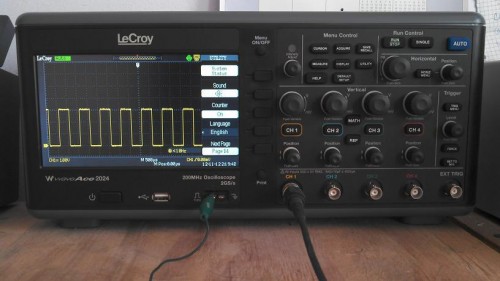Oscilloscopes -Part 1
Hello-
It’s been nearly 3 months since I last posted (bad, distracted, Sophi), and I went back and forth about whether or not to post about my new Art project (hint: it involves temperature control and major logistics) or Engineering.
I’ve decided to write about one of my most useful lab tools, the oscilloscope. An oscilloscope lets you see invisible electrical signals, usually showing how they change over time. The X- axis is time (inverse of frequency) and the Y- axis is amplitude. Other useful things an oscilloscope will show you is how much noise there is in the area of interest, how much of the signal is AC or DC and if your component is not working.
Actually seeing if your component is not working at all is pretty easy- just put the scope on the output and see if anything happens. It’s way more annoying when the component is working just a little bit and puts out an unclear signal.
Photo of a Teledyne LeCroy oscilloscope –
for the purpose of the photo, it’s showing a calibrated 1kHz signal from the scope itself.
Typically, modern oscilloscopes are digital oscilloscopes. Old oscilloscopes are analog. Simply put, this means that analog oscilloscopes display the original signal and that digital oscilloscopes process the signal from analog to digital. There’s tons of information out there about the differences between them. Let us know in the comments if you find some interesting trivia!
There are a few specifications to look for when buying an oscilloscope, over the next few posts, I want to discuss the following: bandwidth, sampling rate, triggering, memory. We’ll also discuss probes and the different kinds you can get. I’m going to be visiting a lab next week where they look at picoVolts and they use special probes for less noise.
I bought my first oscilloscope off of eBay for $140 in 2006. It’s an analog oscilloscope and made by a company called SPECO, which I’m not even sure if it exists anymore. It also looks like I may have paid too much- as I wrote this post, I looked for a link to it, and you can now buy it on eBay for $35.
You’ve heard the expression you get what you pay for?
In the case of the cheap SPECO, it’s true.
The SPECO has a bandwidth of 20 MHz, the LeCroy pictured above has a bandwidth of 200 MHz! I also have another oscilloscope made by OWON that has a bandwidth of 60 MHZ.
The ultimate goal is to get your input signal represented accurately on the screen of the oscilloscope! So you need to choose a scope with a bandwidth large enough to show your signal range. So what does bandwidth mean exactly in the context of oscilloscopes? What can you even look at with such a small bandwidth of 20 MHz? What kinds of signals need the resolution of 200 MHz?
Bandwidth is defined as the frequency at which a sinusoidal input signal is attenuated to 70.7% of its original amplitude. This is also called the -3 dB point. At the -3 dB point, the signal of interest will start to distort so you need to choose your scope so that it has a frequency range large enough to not lose any signal amplitude.
I’ve seen a number of slightly different recommendations around- but most online recommendations agree that buying an oscilloscope with bandwidth with at least 5 times the highest frequency component in your signal will achieve good results. If I want to look at a signal of 40 MHz, then the LeCroy oscilloscope pictured above is a good choice. If I am only going to look at signals to troubleshoot if a switch is on or off, then a lower bandwidth oscilloscope is fine.
Some of the signals I look at are:
RF detection chips– low MHz to GHz! Needs a high bandwidth oscilloscope like the one in the picture above
555 timer signals– microseconds/ high-KHz, low MHz! Can get by with the Owon, although I would never recommend that oscilloscope to anyone. After I wiggle some wires around, I can get good results with my analog scope too.
PIC Microprocessors– nanoseconds/ high MHz Needs a higher bandwidth oscilloscope
That’s it for today- my next post will discuss sampling rate and what it means.
What kind of oscilloscope do you have and more practically, what kind of signals are you looking at?